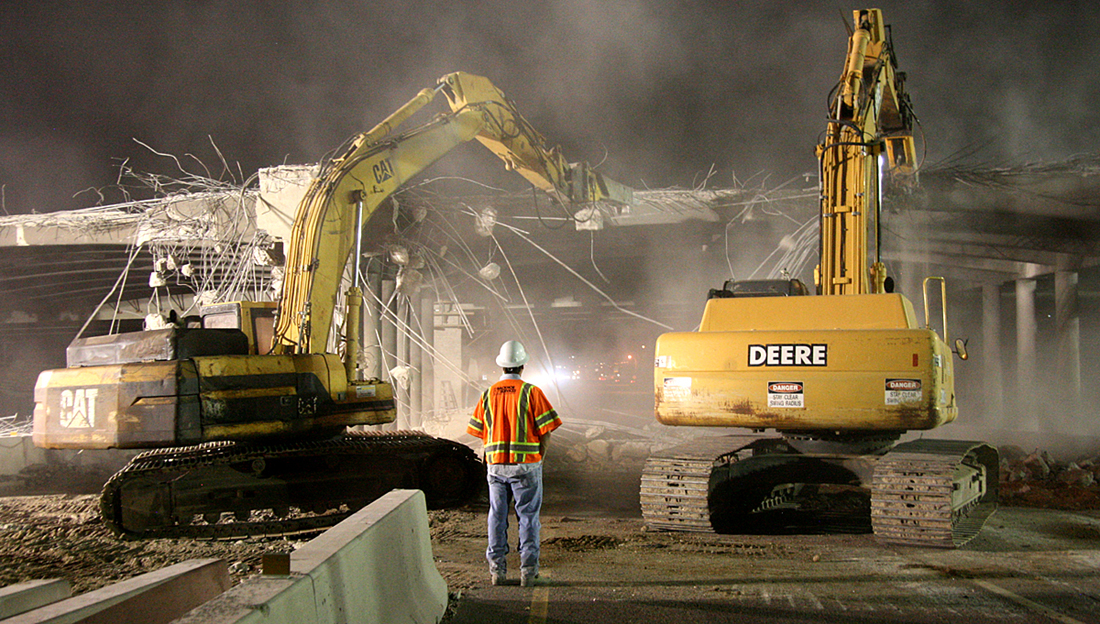 Sept. 15: David Ramsdale, owner of Backhoe
Services, watches
two of his heavy units team up on the demolition of a 45-foot lengthwise
segment of the old Fillmore/I-25 bridge during overnight work Sept. 15. At left is
a Caterpillar 330; at right
is a John Deere 330CLC. Each weighs 77,000 pounds and is using a 10,000-
pound, hydraulic breaker
attachment. The view is from I-25 (closed for the night at the interchange),
looking south.
Sept. 15: David Ramsdale, owner of Backhoe
Services, watches
two of his heavy units team up on the demolition of a 45-foot lengthwise
segment of the old Fillmore/I-25 bridge during overnight work Sept. 15. At left is
a Caterpillar 330; at right
is a John Deere 330CLC. Each weighs 77,000 pounds and is using a 10,000-
pound, hydraulic breaker
attachment. The view is from I-25 (closed for the night at the interchange),
looking south.
|
|
Photo essay: Cutting the old Fillmore bridge down to size - Phase 2
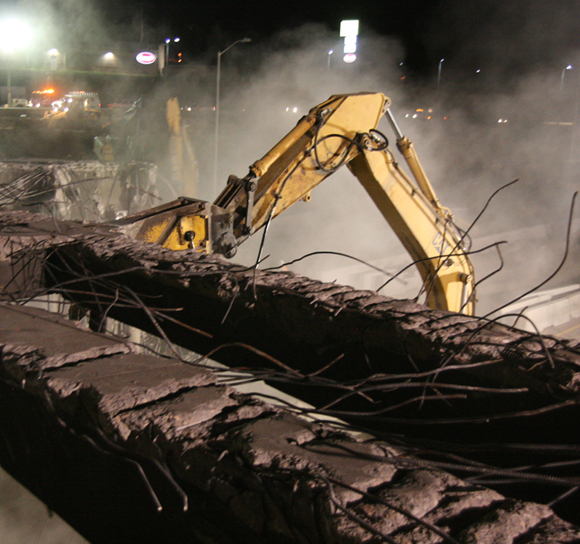 Sept. 15: The long arm and breaker attachment
of an excavator resembles
a preying mantis as it attacks a girder on the 45-foot-wide segment of the old
Fillmore bridge that was being
removed. In the background can be seen a line of cars being routed around the
interchange on the southbound off-ramp.
Sept. 15: The long arm and breaker attachment
of an excavator resembles
a preying mantis as it attacks a girder on the 45-foot-wide segment of the old
Fillmore bridge that was being
removed. In the background can be seen a line of cars being routed around the
interchange on the southbound off-ramp.
|
The latest milestone has been achieved in the Fillmore/I-25 interchange project,
with the
successful removal of the northern, 45-foot-wide segment of the old bridge.
Overnight work in two phases over the past two weeks got the job done the night
of Sept.
16, although final demolition work on the east and west sides of the traffic lanes
will
continue for several days, according to David Ramsdale, whose Backhoe Services
company handled the operation, using a variety of heavy equipment.
This should mean the end of overnight closures at the interchange for at least a
few weeks,
according to a spokesperson for SEMA Construction, the project contractor for
the
Colorado Department of Transportation (CDOT). In the meantime, eastbound
traffic will
be using the new south bridge (completed in early September) while westbound
traffic will use the
remaining 28-foot width of the old bridge.
Plans call for work to start soon on caissons for the piers to support the new north
bridge,
which will go in the space where the cut-away section of the old bridge was.
The demolition work was preceded by a series of cuts on the old bridge with large,
high-powered saws - the first ones through the 10-inch-thick bridge deck,
followed by deeper ones (up to 6
feet) to separate the columns (called "pier caps") that were earmarked for removal.
This allowed
his large excavating rigs (up to 40 tons in weight, using hydraulic drivers with
hammer
attachments), to smash away at the old piers and girders without harming the 28-
foot
portion, Ramsdale explained.
During the work, concrete chunks - from small sizes to a ton or more - fell to the
interstate below, which had been covered with a layer of dirt to protect the driving
surface.
All the dirt and debris were cleaned up by early morning Sept. 17, so that
motorists on Fillmore -
who until Sept. 9 were still using only the old bridge, which was then at its full
width -
found the current new bridge/old-but-narrower bridge alignment (as described
above).
Further details are provided in the cutlines for the photos on this page, most of
which were
shot the nights of Sept. 15 and 16.
The $15.1 million project is slated for completion by next summer. A more
certain date has
not been officially announced because much of the work on the north bridge - as
well as
the ensuing demolition of the 28-foot old segment - will occur during the colder
months,
meaning weather could be a factor.
A Westside Pioneer article from six days ago, "Cutting the old Fillmore
bridge down to size -
Phase 1," can be accessed by clicking this link.
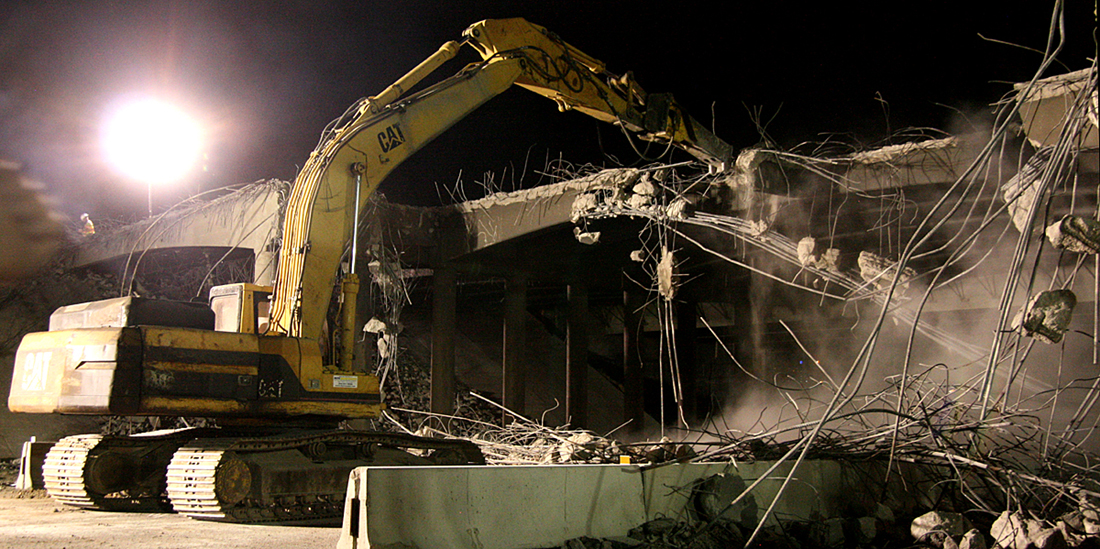 Later Sept. 15: The John Deere unit had to be
temporarily retired for
repairs, leaving the Caterpillar to mash away by itself for a while.
Later Sept. 15: The John Deere unit had to be
temporarily retired for
repairs, leaving the Caterpillar to mash away by itself for a while.
|
|
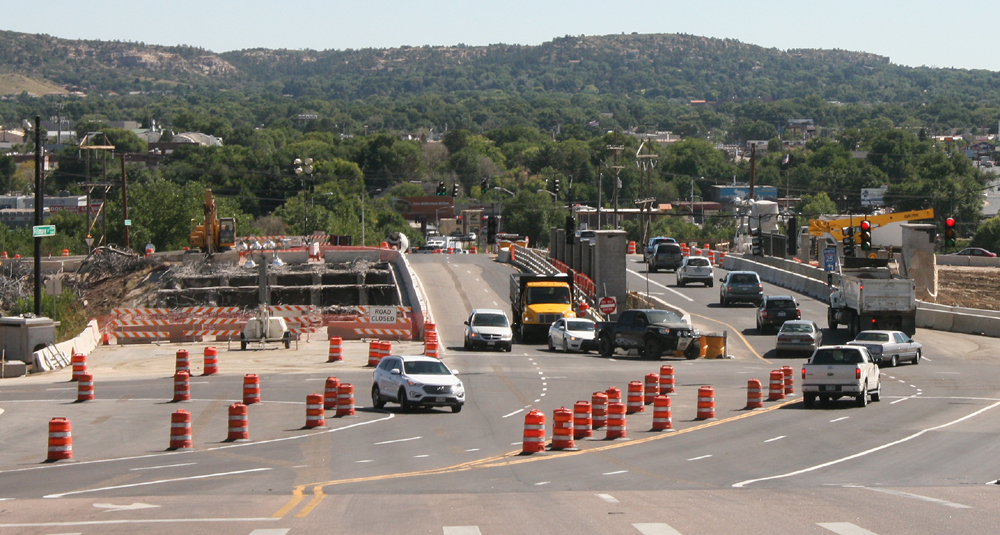 Looking east from Fillmore Street, this was
how the Fillmore interchange looked on the morning of Sept. 16
- in a one-day-only view - after the first night of demolition work to remove a 45-
foot-wide segment of the
old bridge. Although it's not fully clear from this angle, the central girders (those
on either side of the
middle set of columns with cross-members) had been removed at this point.
Looking east from Fillmore Street, this was
how the Fillmore interchange looked on the morning of Sept. 16
- in a one-day-only view - after the first night of demolition work to remove a 45-
foot-wide segment of the
old bridge. Although it's not fully clear from this angle, the central girders (those
on either side of the
middle set of columns with cross-members) had been removed at this point.
|
|
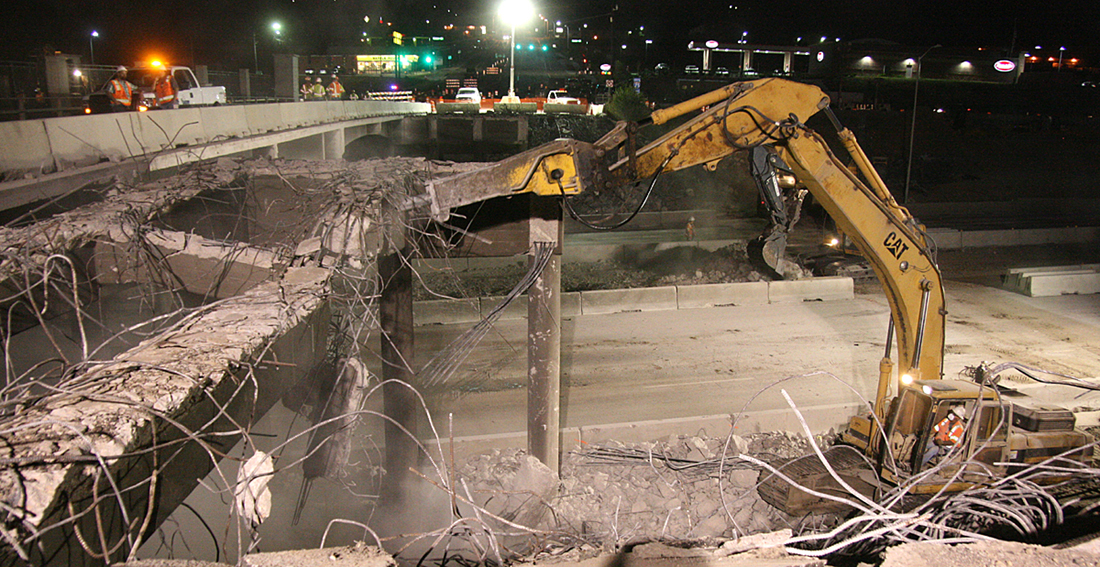 Sept. 16: This is the first of three sequential
shots, showing a girder and
cross-member from the old bridge coming down together during the demolition,
while workers with CDOT,
SEMA and Backhoe Services watch from the bridge. Note the straight saw cut
below the concrete barrier, which allowed the to-be-demolished portion of the old
bridge to be pulled away without damaging the segment that's being retained for
now. The next two photos in the sequence appear below.
Sept. 16: This is the first of three sequential
shots, showing a girder and
cross-member from the old bridge coming down together during the demolition,
while workers with CDOT,
SEMA and Backhoe Services watch from the bridge. Note the straight saw cut
below the concrete barrier, which allowed the to-be-demolished portion of the old
bridge to be pulled away without damaging the segment that's being retained for
now. The next two photos in the sequence appear below.
|
|
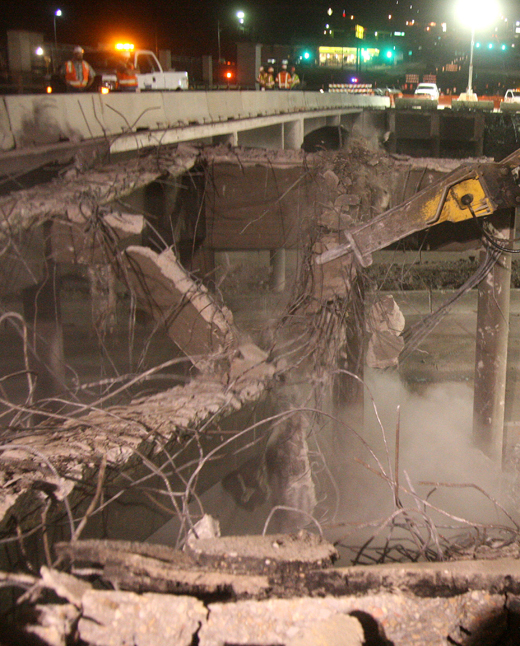
|
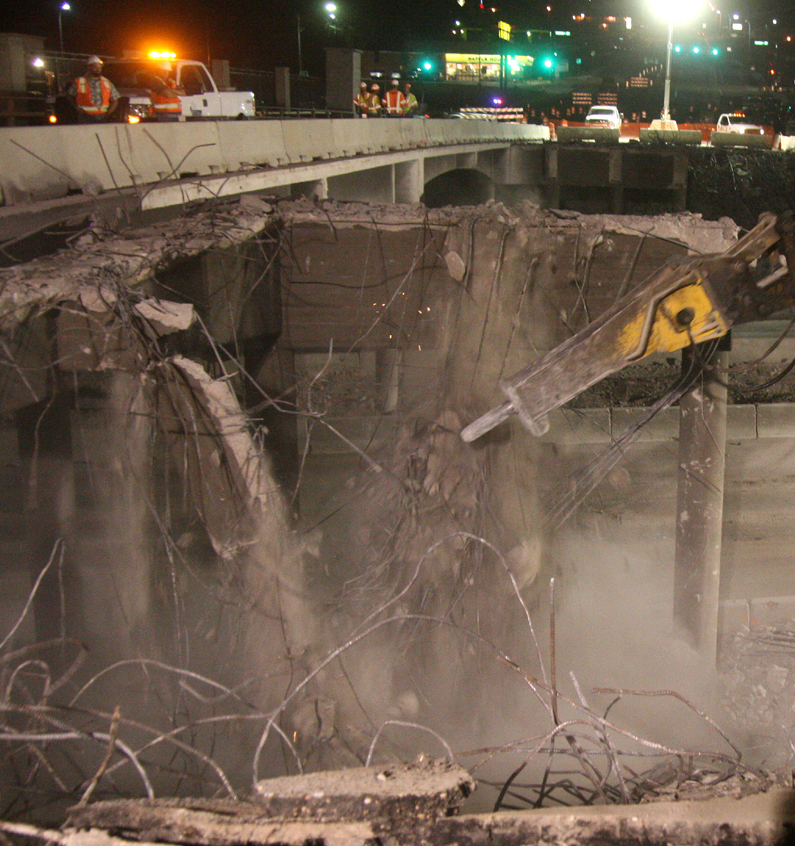 Sept. 16: The sequential shots after the photo
above... LEFT: The
weakened, broken beams start to fall. RIGHT: Complete collapse.
Sept. 16: The sequential shots after the photo
above... LEFT: The
weakened, broken beams start to fall. RIGHT: Complete collapse.
|
|
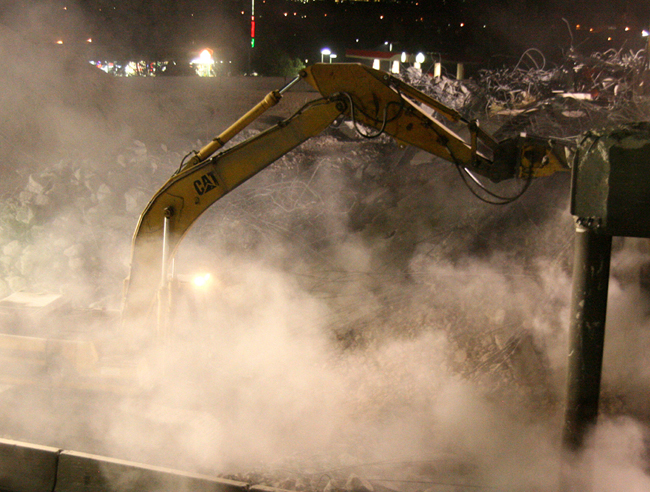 Sept. 16... LEFT: A cloud of dust from the
demolition work envelopes
the Caterpillar cab. RIGHT: A Backhoe Services worker uses a welding torch to
cut rebar from the old
bridge into manageable sizes for recycling.
Sept. 16... LEFT: A cloud of dust from the
demolition work envelopes
the Caterpillar cab. RIGHT: A Backhoe Services worker uses a welding torch to
cut rebar from the old
bridge into manageable sizes for recycling.
|

|
|
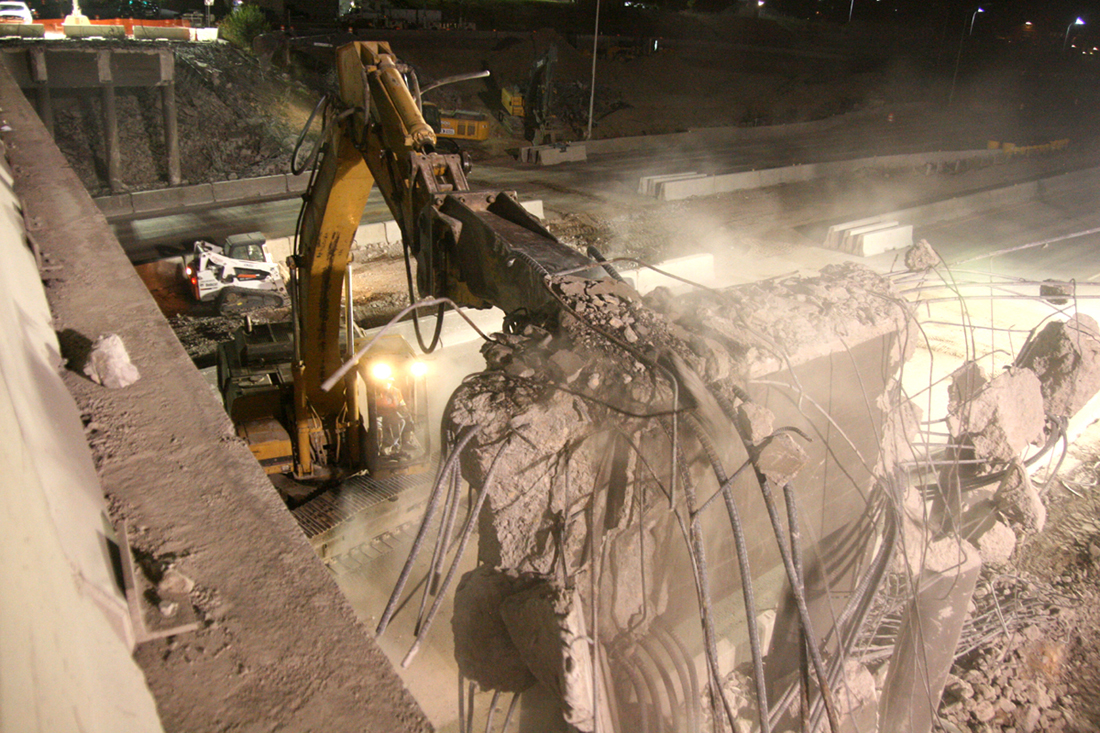 Sept. 16: After repeated hits with the
Caterpillar's hammer attachment, the
remnant of one of the last pier caps (the column pair with cross-member) teeters
before falling.
Sept. 16: After repeated hits with the
Caterpillar's hammer attachment, the
remnant of one of the last pier caps (the column pair with cross-member) teeters
before falling.
|
|
 This was how the Fillmore/I-25 bridge looked
on
the morning of Sept. 17, after the final overnight interchange closure to demolish
the northerly
45-foot-wide segment of the old bridge. As planned, additional work continues
(background left) to remove
the abutments for that part of the old bridge, and a thicket of salvaged rebar awaits
removal on the west side of the interstate. The new north bridge will go
approximately where the removed
old section was. Westbound traffic moves over the remaining 28-foot-wide
segment and eastbound traffic
over the new south bridge (defined by the raised ornamental piers on either side).
In the foreground are
vehicles approaching the interchange from the temporary southbound I-25
off-ramp. The photo was taken
looking southeast from the Kum & Go parking lot at Fillmore and Chestnut.
This was how the Fillmore/I-25 bridge looked
on
the morning of Sept. 17, after the final overnight interchange closure to demolish
the northerly
45-foot-wide segment of the old bridge. As planned, additional work continues
(background left) to remove
the abutments for that part of the old bridge, and a thicket of salvaged rebar awaits
removal on the west side of the interstate. The new north bridge will go
approximately where the removed
old section was. Westbound traffic moves over the remaining 28-foot-wide
segment and eastbound traffic
over the new south bridge (defined by the raised ornamental piers on either side).
In the foreground are
vehicles approaching the interchange from the temporary southbound I-25
off-ramp. The photo was taken
looking southeast from the Kum & Go parking lot at Fillmore and Chestnut.
|
|
Westside Pioneer article and photos
(Posted 9/17/15;
Transportation:
Fillmore/I-25)
Would you like to respond to this article? The Westside
Pioneer welcomes letters at
editor@westsidepioneer.com.
(Click here for letter-writing criteria.)
|
 Sept. 15: The long arm and breaker attachment
of an excavator resembles
a preying mantis as it attacks a girder on the 45-foot-wide segment of the old
Fillmore bridge that was being
removed. In the background can be seen a line of cars being routed around the
interchange on the southbound off-ramp.
Sept. 15: The long arm and breaker attachment
of an excavator resembles
a preying mantis as it attacks a girder on the 45-foot-wide segment of the old
Fillmore bridge that was being
removed. In the background can be seen a line of cars being routed around the
interchange on the southbound off-ramp.
 Sept. 15: David Ramsdale, owner of Backhoe
Services, watches
two of his heavy units team up on the demolition of a 45-foot lengthwise
segment of the old Fillmore/I-25 bridge during overnight work Sept. 15. At left is
a Caterpillar 330; at right
is a John Deere 330CLC. Each weighs 77,000 pounds and is using a 10,000-
pound, hydraulic breaker
attachment. The view is from I-25 (closed for the night at the interchange),
looking south.
Sept. 15: David Ramsdale, owner of Backhoe
Services, watches
two of his heavy units team up on the demolition of a 45-foot lengthwise
segment of the old Fillmore/I-25 bridge during overnight work Sept. 15. At left is
a Caterpillar 330; at right
is a John Deere 330CLC. Each weighs 77,000 pounds and is using a 10,000-
pound, hydraulic breaker
attachment. The view is from I-25 (closed for the night at the interchange),
looking south.
 Later Sept. 15: The John Deere unit had to be
temporarily retired for
repairs, leaving the Caterpillar to mash away by itself for a while.
Later Sept. 15: The John Deere unit had to be
temporarily retired for
repairs, leaving the Caterpillar to mash away by itself for a while.
 Looking east from Fillmore Street, this was
how the Fillmore interchange looked on the morning of Sept. 16
- in a one-day-only view - after the first night of demolition work to remove a 45-
foot-wide segment of the
old bridge. Although it's not fully clear from this angle, the central girders (those
on either side of the
middle set of columns with cross-members) had been removed at this point.
Looking east from Fillmore Street, this was
how the Fillmore interchange looked on the morning of Sept. 16
- in a one-day-only view - after the first night of demolition work to remove a 45-
foot-wide segment of the
old bridge. Although it's not fully clear from this angle, the central girders (those
on either side of the
middle set of columns with cross-members) had been removed at this point.
 Sept. 16: This is the first of three sequential
shots, showing a girder and
cross-member from the old bridge coming down together during the demolition,
while workers with CDOT,
SEMA and Backhoe Services watch from the bridge. Note the straight saw cut
below the concrete barrier, which allowed the to-be-demolished portion of the old
bridge to be pulled away without damaging the segment that's being retained for
now. The next two photos in the sequence appear below.
Sept. 16: This is the first of three sequential
shots, showing a girder and
cross-member from the old bridge coming down together during the demolition,
while workers with CDOT,
SEMA and Backhoe Services watch from the bridge. Note the straight saw cut
below the concrete barrier, which allowed the to-be-demolished portion of the old
bridge to be pulled away without damaging the segment that's being retained for
now. The next two photos in the sequence appear below.

 Sept. 16: The sequential shots after the photo
above... LEFT: The
weakened, broken beams start to fall. RIGHT: Complete collapse.
Sept. 16: The sequential shots after the photo
above... LEFT: The
weakened, broken beams start to fall. RIGHT: Complete collapse.
 Sept. 16... LEFT: A cloud of dust from the
demolition work envelopes
the Caterpillar cab. RIGHT: A Backhoe Services worker uses a welding torch to
cut rebar from the old
bridge into manageable sizes for recycling.
Sept. 16... LEFT: A cloud of dust from the
demolition work envelopes
the Caterpillar cab. RIGHT: A Backhoe Services worker uses a welding torch to
cut rebar from the old
bridge into manageable sizes for recycling.

 Sept. 16: After repeated hits with the
Caterpillar's hammer attachment, the
remnant of one of the last pier caps (the column pair with cross-member) teeters
before falling.
Sept. 16: After repeated hits with the
Caterpillar's hammer attachment, the
remnant of one of the last pier caps (the column pair with cross-member) teeters
before falling.
 This was how the Fillmore/I-25 bridge looked
on
the morning of Sept. 17, after the final overnight interchange closure to demolish
the northerly
45-foot-wide segment of the old bridge. As planned, additional work continues
(background left) to remove
the abutments for that part of the old bridge, and a thicket of salvaged rebar awaits
removal on the west side of the interstate. The new north bridge will go
approximately where the removed
old section was. Westbound traffic moves over the remaining 28-foot-wide
segment and eastbound traffic
over the new south bridge (defined by the raised ornamental piers on either side).
In the foreground are
vehicles approaching the interchange from the temporary southbound I-25
off-ramp. The photo was taken
looking southeast from the Kum & Go parking lot at Fillmore and Chestnut.
This was how the Fillmore/I-25 bridge looked
on
the morning of Sept. 17, after the final overnight interchange closure to demolish
the northerly
45-foot-wide segment of the old bridge. As planned, additional work continues
(background left) to remove
the abutments for that part of the old bridge, and a thicket of salvaged rebar awaits
removal on the west side of the interstate. The new north bridge will go
approximately where the removed
old section was. Westbound traffic moves over the remaining 28-foot-wide
segment and eastbound traffic
over the new south bridge (defined by the raised ornamental piers on either side).
In the foreground are
vehicles approaching the interchange from the temporary southbound I-25
off-ramp. The photo was taken
looking southeast from the Kum & Go parking lot at Fillmore and Chestnut.